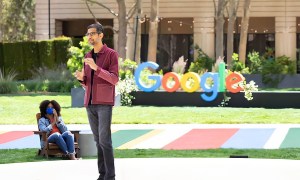
Project Ara is Google’s vision for the future of smartphones. Rather than having to buy a new device every few years to get the latest and greatest updates and specs, the company wants to make phones modular. That means if speaker or camera technology improves, you’ll be able to buy those parts and simply tack them onto your phone, replacing the older modules.
Google’s Engineering Lead Rafa Camargo demoed the developer version of an Ara phone which had six modular slots, and the installation process is apparently very simple.

““Step one, plug in a module,” he said. “Step two, use it.” Camargo plugged in a camera module, and then used it almost immediately to take a photo of the audience.
You can use an app to eject a module, but the coolest part of the demo was when the Ara representative said, “OK Google, eject my camera.” That received rather energetic applause.
Ara is an open platform, so anyone will be able to create modules and devices to be compatible with modules. The company will release a developer kit of Ara in the fourth quarter of 2016. Google has also been creating its own modules, including ones for high-quality speakers, high-resolution cameras, high-capacity storage, as well as decorative wood, concrete, and colorful modules for personalization.

But modules can extend much further than speakers, cameras, and even secondary displays. It could help someone check insulin levels if they have diabetes, for example. Google is partnering with several companies, including Sony, Samsung, Panasonic, Harman, E-Ink, Cohero Health, and more, to bring all sorts of modules and devices to market.

Google’s first Ara phone is set to be released in 2017. Google gave us a glimpse of the device in the image above, but it’s unclear if that’s what it will look like. Project Ara has been delayed before, so we hope this new target date will certainly hit the mark.
When? 2016. #yeswearelate #ProjectAra
— Project Ara (@ProjectAra) August 17, 2015
It’s odd that the company saved some of its most interesting projects for the last day, but I guess you’re supposed to save the best for last. Google unveiled a Commuter jacket from ATAP’s Project Jacquard that would enable people to control their phones via gestures made on the sleeve of the jacket; as well as a developer kit for Project Soli, a new radar-based method to interact with the tech around us via gestures in mid-air.

